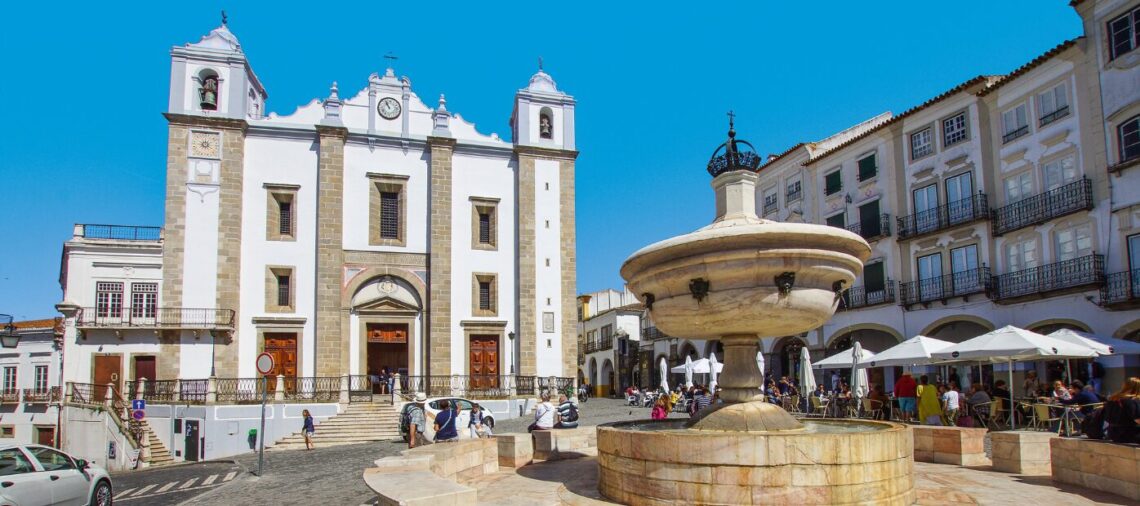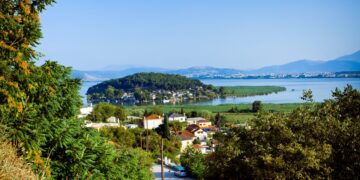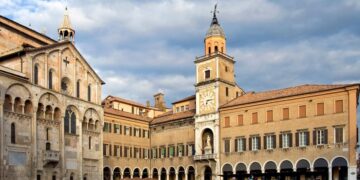As a first-time traveller in Evora, the beautiful Portuguese town, you may wonder how to make the most of your visit. Below, we will provide essential tips to ensure a seamless and unforgettable experience. From exploring the captivating attractions to indulging in traditional crafts, Evora offers a sense of freedom and adventure like no other. So, let’s dive in and discover the wonders that await you on this UNESCO World Heritage site. Get ready to fall in love with Evora, and follow these tips for visiting Evora!
Where is Evora located in Portugal?

Evora is located in the southern region of Portugal, making it a perfect destination for those seeking a taste of the Mediterranean climate and charm. Situated about 85 kilometers east of Lisbon, Evora is easily accessible by road and public transportation. Its strategic location allows you to explore nearby cities such as Lisbon, which is just a short drive away, or take a day trip to the stunning coastal town of Setubal.
The geography of Evora is characterized by rolling plains and vineyards, creating a picturesque backdrop for your adventures. The city itself is known for its well-preserved medieval walls, narrow streets, and historic landmarks, offering a glimpse into the rich cultural heritage of the region.
When it comes to transportation options, Evora offers a range of choices. You can choose to rent a car and explore the surrounding areas at your own pace, or take advantage of the efficient public transportation system, which includes buses and trains.
What is the history of Evora?

Évora, the city in the Alentejo region of Portugal, boasts a rich and diverse history that spans several millennia. Its origins can be traced back to the Roman period when it was known as Ebora. Under Roman rule, Évora flourished as a center of culture and commerce, with its significance evident in the remnants of that era, such as the Temple of Diana, a well-preserved Roman temple, and the Roman baths. The city’s strategic location on a hilltop provided a defensive advantage, making it an important urban center in ancient times. After the fall of the Roman Empire, Évora witnessed a series of invasions and rulers, including the Visigoths and the Moors, who each left their mark on the city’s architecture and culture.
In the 12th century, Évora became a pivotal part of the Christian Reconquista under the leadership of Giraldo the Fearless, who reconquered it from the Moors. This era marked a significant transformation in the city’s character, with the construction of many medieval buildings, including churches and monasteries, that gave Évora its distinctive historic charm.
The 15th and 16th centuries were a golden age for Évora, as it became a residence for Portuguese kings, leading to a cultural and architectural renaissance. Notable structures from this period include the Royal Palace of Évora and the University of Évora, one of the oldest universities in Portugal.
This historical significance has led to Évora being designated as a UNESCO World Heritage Site, a testament to its rich tapestry of cultural influences and architectural styles spanning from Roman times to the present day.
What is Évora Portugal known for?

One of the main draws of Évora Portugal is its rich cultural heritage. The city is known for its stunning architecture, which reflects its long history and various influences. The Roman temple, located in the city center, is a prime example of Évora’s architectural wonders. This well-preserved structure dates back to the 1st century AD and is a testament to the city’s Roman past.
Another highlight of Évora is its connection to Alentejo wine. The region surrounding the city is famous for its vineyards and produces some of the finest wines in Portugal. As a visitor, you can indulge in wine tastings and learn about the winemaking process while enjoying the breathtaking views of the countryside.
For those seeking a more unique experience, the Chapel of Bones is a must-visit. Located within the Church of São Francisco, this macabre chapel is adorned with human skulls and bones, serving as a reminder of the transient nature of life. It is a haunting yet fascinating sight that will leave a lasting impression.
Évora is also home to the University of Évora, one of the oldest universities in Portugal. Founded in 1559, it has a rich academic history and is known for its high-quality education and research. The university adds a vibrant and intellectual atmosphere to the city, with its beautiful campus and diverse student population.
Buy an activity in Evora, Portugal:
What are the main attractions in Evora?
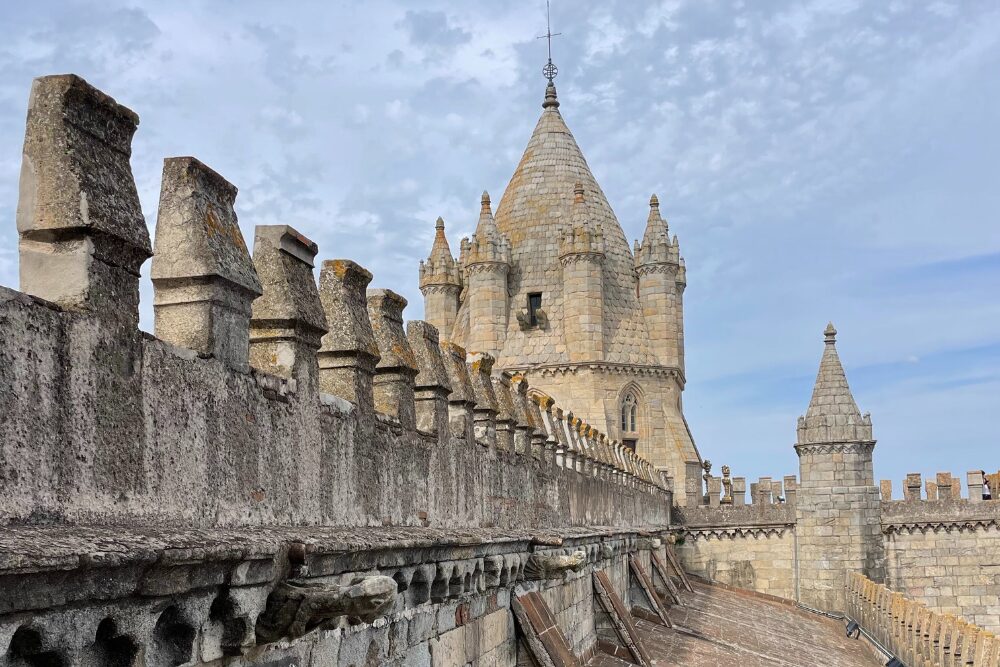
When exploring Évora for the first time, you’ll find a plethora of captivating attractions to discover. This charming city in Portugal is known for its rich history and well-preserved architecture. These are the main attractions in Évora:
Temple of Diana
The so-called Temple of Diana is one of the most iconic landmarks of Évora, a striking example of Roman architecture. Dating back to the 1st century AD, this temple has remarkably well-preserved Corinthian columns, making it one of the best-preserved Roman structures in Portugal. Despite its name, the temple was likely dedicated to Emperor Augustus rather than the goddess Diana, a common misconception based on a legend from the 17th century.
The temple’s survival through the ages is partly due to its conversion into a fortress during the Middle Ages and later into a small slaughterhouse in the 19th century. Its resilience and adaptability through various historical periods have made it a symbol of the city’s enduring legacy. The temple’s podium is almost completely intact, a rare feature among surviving Roman temples, offering a glimpse into ancient construction techniques.
Évora Cathedral (Sé de Évora)
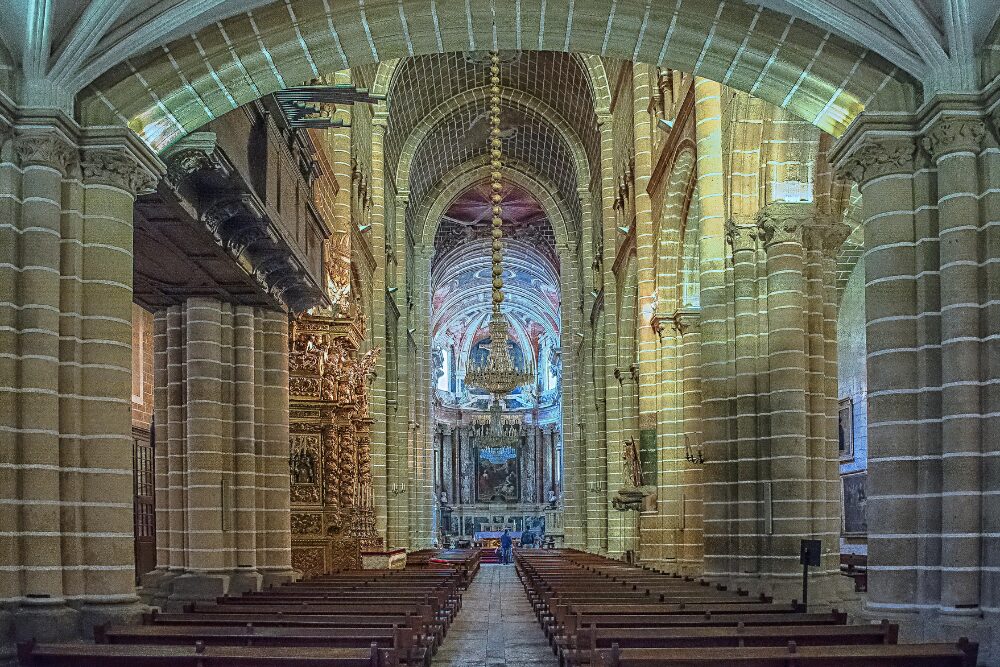
The Sé de Évora, a masterpiece of Gothic architecture, dates back to the late 13th century. Its construction commenced just after the Reconquista, symbolizing the Christian dominance in the region. The cathedral has undergone several modifications over the centuries, incorporating Romanesque and Baroque elements, which add to its architectural splendor.
Inside the cathedral, you’ll find a fascinating mix of religious art, including a 15th-century sculpted depiction of the Apostles and an impressive main chapel altar. A little-known fact is that the cathedral houses a relic believed to be a part of the Holy Cross. Also, don’t miss the chance to climb up to the roof for a panoramic view of Évora and its surroundings, offering one of the best vistas in the city.
University of Évora

The University of Évora, founded in 1559 by Cardinal Infante Dom Henrique, initially served as a Jesuit college. It’s one of the earliest universities in Portugal, showcasing a stunning Renaissance cloister and a unique 16th-century classroom layout. The university was closed in 1759 by the Marquis of Pombal and only reopened in the 20th century.
The university’s Baroque-style chapel and the Sala dos Actos, adorned with azulejos (traditional Portuguese tiles) and intricate woodwork, are highlights. The university played a crucial role in the intellectual and scientific development of Portugal, with notable alumni and faculty contributing significantly to various fields. Today, it remains an important educational and cultural institution in Évora.
Chapel of Bones (Capela dos Ossos)

The Chapel of Bones is one of the most famous and macabre monuments in Évora. Built in the 17th century by Franciscan monks, its walls and columns are covered with human bones and skulls, estimated to be from over 5,000 corpses. The chapel was constructed as a memento mori, to remind visitors of the transient nature of human life.
The entrance of the chapel bears the chilling inscription: “Nós ossos que aqui estamos pelos vossos esperamos” (“We bones that are here, for yours await”). This evocative message sets the tone for what is an unforgettable experience. The bones came from the graves of the city’s overcrowded churchyards, making this chapel a poignant reflection on life, death, and the passage of time.
Évora’s Historic Centre

The historic center of Évora, a UNESCO World Heritage Site, is a beautifully preserved medieval town. It’s a labyrinth of cobbled streets, charming squares, and whitewashed houses. This center is an amalgam of centuries of history, displaying influences from Roman, Gothic, and Moorish periods, among others.
Within its walls, you’ll find numerous Roman ruins, including the remains of a bath complex beneath the City Hall. The Giraldo Square (Praça do Giraldo), the heart of Évora, is named after Giraldo the Fearless, the man who reconquered the town from the Moors. The square has been a site of significant historical events, including public executions during the Inquisition.
Almendres Cromlech

The Almendres Cromlech, located just outside Évora, is a significant Neolithic site. Dating back to around 6000 BCE, it predates Stonehenge and is one of the largest and oldest megalithic complexes in Europe. The site comprises roughly 95 granite stones arranged in circular and elliptical formations amidst a serene landscape.
Many of the stones at Almendres feature enigmatic carvings, thought to represent solar and lunar cycles, suggesting the site’s use for astronomical and ceremonial purposes. The alignment of the stones indicates a sophisticated understanding of astronomy by its creators. The site was rediscovered only in the 1960s, having been covered by vegetation for centuries, adding to its mystique as a hidden historical treasure.
Évora Museum (Museu de Évora)

Housed in the former Episcopal Palace, the Évora Museum is a treasure trove of art and history. Its collections span from the Roman period to the modern age, including a diverse range of paintings, sculptures, and artifacts. The museum’s layout and design reflect the historical evolution of the building and the city.
One of the museum’s highlights is a rare set of Flemish tapestries, considered among the finest in Portugal. Additionally, it has an impressive collection of religious art and artefacts from the region, providing insights into Évora’s rich ecclesiastical history. The museum also showcases pieces from the Roman and Moorish periods, highlighting the city’s multicultural past.
São Francisco Church

The São Francisco Church, completed in the early 16th century, is a blend of Gothic and Manueline architectural styles. The church is renowned for its ornate design and the emblematic symbols of the Manueline style, which reflect Portugal’s maritime discoveries and trade with exotic lands during the Age of Discovery.
One of the most unique aspects of the church is the Bone Chapel, an annex that, similar to the Chapel of Bones, is adorned with thousands of human bones and skulls. The church also houses the Image of the Lord Jesus of the Steps, known for its annual procession during Holy Week, a deeply rooted tradition in Évora.
Palace of the Dukes of Cadaval

The Palace of the Dukes of Cadaval, situated near the Roman Temple, showcases a blend of architectural styles from Moorish to Gothic and Manueline. The palace has been the residence of the Dukes of Cadaval for centuries, and parts of it are still used by the family today.
The palace features a private chapel adorned with exquisite Sevillian azulejos and a collection of family portraits, tapestries, and historic documents. The palace’s library is renowned for its rare collection of books and manuscripts. Additionally, the palace occasionally hosts cultural events and exhibitions, contributing to Évora’s vibrant cultural scene.
Is Evora a UNESCO World Heritage site?

Evora holds the distinction of being a UNESCO World Heritage site, making it a must-visit destination for travelers seeking cultural and historical treasures. This recognition by UNESCO highlights the city’s outstanding universal value and its significance in terms of cultural heritage. Evora’s designation as a World Heritage site is a testament to its rich history and the preservation efforts that have been undertaken to safeguard its historic sites and monuments.
As a UNESCO World Heritage site, Evora is home to numerous historic sites that showcase its rich past. The city’s well-preserved medieval walls, impressive Roman temple, and the famous Cathedral of Evora are just a few examples of the architectural wonders you can explore. These landmarks offer a glimpse into the city’s diverse history and the influences of different civilizations that have shaped Evora over the centuries.
Evora’s status as a World Heritage site also brings global recognition and attracts visitors from all over the world. The UNESCO designation not only acknowledges the city’s historical significance but also serves as a guarantee of the city’s commitment to preserving its cultural heritage.
What is the weather like in Evora?

To get an idea of the weather in Evora, you can typically expect mild to hot temperatures throughout the year. Evora, located in the Alentejo region of Portugal, experiences a Mediterranean climate, characterized by warm summers and mild winters. The city enjoys an average of 300 sunny days annually, making it an ideal destination for those seeking warm weather and outdoor activities.
In the summer months, from June to September, temperatures in Evora can reach highs of around 35°C (95°F). The days are long and sunny, perfect for exploring the city’s historic sites or lounging by the pool. However, it is important to pack sunscreen, a hat, and lightweight clothing to stay comfortable in the heat.
During the winter months, from December to February, Evora experiences cooler temperatures, with average highs ranging from 12°C to 16°C (54°F to 61°F). While it may not be as hot as in the summer, the weather is still pleasant for sightseeing and outdoor activities. It is advisable to bring a jacket or sweater for cooler evenings.
Spring and autumn are transitional seasons in Evora, with temperatures ranging from 18°C to 25°C (64°F to 77°F). These seasons offer mild weather and are the perfect time to explore the city’s beautiful gardens and enjoy outdoor dining.
It is always a good idea to check the Evora weather forecast before your trip to ensure you are prepared for the current conditions.
What are some traditional dishes in Evora?

When visiting Evora for the first time, you’ll be delighted to discover the delicious traditional dishes that showcase the rich culinary heritage of the region. Evora is known for its traditional gastronomy, offering a wide variety of popular local foods that are a must-try for any food lover.
One of the most famous dishes in Evora is the Sericaia, a traditional Portuguese dessert made with eggs, sugar, cinnamon, and served with plums.
Another local specialty is the Ensopado de Borrego, a hearty lamb stew cooked with garlic, red wine, and aromatic herbs.
The Queijo de Evora, a creamy and tangy sheep’s milk cheese, is another delicacy that you shouldn’t miss.
For seafood lovers, the traditional seafood rice, Arroz de Marisco, is a must-try dish, consisting of a flavorful rice cooked with a variety of fresh seafood such as clams, shrimp, and mussels.
Finally, make sure to try the Alentejo-style pork dishes, such as the Carne de Porco à Alentejana, a delicious combination of tender pork cubes, clams, and potatoes cooked in a flavorful sauce. These traditional dishes in Evora will surely take you on a culinary journey and leave you craving for more.
How far is Evora from Lisbon?

Evora is approximately 130 kilometers away from Lisbon, making it an easily accessible destination for a day trip from the capital city. There are various transportation options available to reach Evora from Lisbon, depending on your preference and convenience.
If you prefer public transportation, taking a train is a popular choice. The train journey from Lisbon to Evora takes around 1.5 to 2 hours, offering scenic views of the Portuguese countryside along the way. Trains are comfortable and provide a hassle-free travel experience.
On the other hand, if you prefer the freedom and flexibility of driving, renting a car is a great option. The journey by car takes approximately 1.5 hours, and you can enjoy the picturesque landscapes at your own pace. Plus, having a car in Evora allows you to explore the surrounding areas and attractions with ease.
Whether you choose to travel by train or car, the distance from Lisbon to Evora is relatively short, making it an ideal day trip destination. You can spend the day exploring the historic city center, visit the famous Roman Temple, wander through the narrow streets, and indulge in the delicious local cuisine.
What are the traditional crafts in Evora?

One must explore the traditional crafts of Evora. This charming city is not only known for its rich history and architectural wonders but also for its thriving artisanal skills and handmade products. The traditional crafts of Evora are deeply rooted in the city’s cultural heritage and showcase the exceptional craftsmanship of its artisans.
One of the most prominent traditional crafts in Evora is pottery. The city is famous for its beautiful ceramic pieces that are meticulously hand-painted with intricate designs. These exquisite creations make for perfect souvenirs to take back home and serve as a reminder of your visit to this enchanting city.
Another traditional craft that Evora is known for is cork art. Portugal is the world’s largest producer of cork, and Evora is no exception. Artisans here skillfully transform this natural material into stunning pieces of art, such as jewelry, bags, and even furniture. The versatility of cork allows for endless possibilities, making each piece unique and environmentally friendly.
In addition to pottery and cork art, Evora is also known for its traditional weaving and embroidery. Skilled artisans use traditional techniques passed down through generations to create beautiful tapestries, rugs, and embroidered textiles. These handmade products not only showcase the talent of the artisans but also preserve the cultural heritage of the region.
What is the best time of year to visit Evora?

If you’re planning a visit to Evora, the best time of year to go is during the spring or fall seasons. The weather in Evora during these times is pleasant, with mild temperatures ranging from 15 to 25 degrees Celsius. You’ll be able to explore the city comfortably without the scorching heat of the summer or the chilly temperatures of the winter.
During your visit, make sure to try some of the traditional dishes in Evora. The region is known for its hearty cuisine, featuring dishes like migas, a bread-based dish with pork, and açorda, a bread soup with garlic and herbs. These dishes are perfect for warming you up during the cooler fall months.
While in Evora, take the time to explore the city’s traditional crafts. The region is famous for its pottery, cork products, and embroidery. Visit the local artisan shops to see the craftsmen at work and pick up some unique souvenirs to take home.
Is Evora a walkable city?

To explore Evora, you can easily navigate the city on foot. Evora is a compact and walkable city, allowing you to meander through its streets and discover its hidden gems at your own pace. As you stroll through the historic center, you’ll be captivated by the city’s rich architecture, which reflects its long and storied past. From Roman ruins to Gothic churches, the buildings in Evora tell a tale of centuries gone by.
Navigating Evora’s landmarks is a breeze when you’re on foot. The city’s most iconic sights, such as the Roman Temple and the Cathedral of Evora, are conveniently located within walking distance. As you explore these landmarks, you’ll uncover the city’s fascinating history and gain insight into its cultural significance.
While Evora’s major attractions are well-known, the real magic lies in uncovering its hidden gems. As you wander off the beaten path, you’ll stumble upon charming squares, quaint cafes, and local artisan shops. These hidden treasures offer a glimpse into the authentic local culture and provide a unique and immersive experience.
Final Thoughts On Tips For Visiting Evora
In conclusion, visiting Évora as a first-time traveler is an absolute must! This charming city has rich history, stunning attractions, and traditional crafts that will transport you to another time. With its UNESCO World Heritage status, Évora is a true gem in Portugal. And the best part? It’s just a short distance from Lisbon, making it easily accessible. So wear your walking shoes and prepare for an unforgettable adventure in the enchanting city of Évora!

